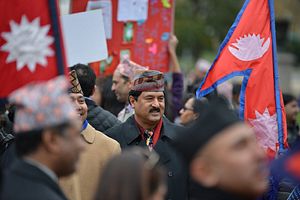Nepal’s new prime minister, Pushpa Kamal Dahal (also known as Prachanda), will visit India later this week for four days, marking his first trip abroad as the Himalayan nation’s head of government. Prachanda, a Maoist politician, was previously prime minister for nine months from 2008 to 2009 and recently returned to the post after his predecessor, Khadga Prasad Oli, failed to survive a no-confidence motion in parliament. Prachanda’s visit to India will largely be poised toward resetting Nepal’s most important bilateral relationship after ties had soured under Oli.
The Nepali premier’s upcoming trip to India is receiving a high degree of attention in New Delhi, where concerns had grown among foreign policy mandarins that India was ceding ground to China in Nepal. As I’ve discussed before in The Diplomat, the primary cause for the precipitous decline in the historically close ties between India and Nepal was New Delhi’s decision to side with ethnic groups protesting Nepal’s new constitution, which was promulgated last year and included problematic provisions on federal districting and electoral participation.
The most acute manifestation of the difficulties between the two countries during the crisis was the cessation of trade across the India-Nepal border as protests grew increasing intense in southern Nepal, depriving the country of much needed fuel and other supplies. Nepali authorities accused New Delhi of instituting a formal blockade to force constitutional changes–a charge strongly denied by Indian officials.
Prachanda’s diplomatic manifesto from day one has been about rebalancing Nepal’s foreign policy between its two mammoth neighbors, India and China. One of the prime minister’s first actions was to dispatch high level special envoys to both countries to offer clarity. Bimalendra Nidhi, Prachanda’s deputy prime minister, was in New Delhi three weeks ago to lay the groundwork for Prachanda’s upcoming visit.
Regarding his agenda in New Delhi, Prachanda hasn’t made any grand promises, noting explicitly that observers shouldn’t expect to see any major bilateral initiatives unveiled. Rather, he seeks to lay a “strong foundation” for mutual trust between the two countries after what he describes as a “bitter experience” during the constitution-related difficulties. “I am confident that the visit (to India) would not only normalize the relations that went through some bitter experience in the recent past, but also build a strong foundation for mutual trust,” he told a parliamentary committee in Kathmandu.
Geopolitically, Beijing will be watching Prachanda closely during his New Delhi visit. There were reports recently that China is dissatisfied with a perceived lack of continuity between Oli, who had signed a range of important agreements with China, and Prachanda. As a result, Chinese President Xi Jinping’s rumored October visit to Nepal may be stricken from the diplomatic calendar this year. Nepal has denied the reports and China’s foreign ministry has been characteristically noncommittal in its reaction.
As an interesting aside, Prachanda, during his first prime ministerial stint, shunned longstanding tradition for Nepali heads of government and visited China on his first trip abroad instead of India. As bad as things got under Oli, the former prime minister also visited India before China–though he threatened to visit Beijing first to send New Delhi a message.
Prachanda has nevertheless sought to assure China that he has no intentions of spurning Beijing’s overtures; China sought to capitalize on both the rift between New Delhi and Kathmandu and Nepal’s general need for aid and infrastructure assistance in the aftermath of last year’s devastating April earthquake. Realistically, however, Nepal’s immense economic reliance on India always meant that China’s attempts at forging new geopolitical inroads would be limited.
Finally, for close observers of India-Nepal ties, Prachanda’s interactions with India are especially interesting given his history of criticizing New Delhi both during his first tenure as prime minister and as a politician more generally. For example, Prachanda once called on Nepali leaders to rip up the 1950 treaty of friendship with India, the cornerstone of the bilateral relationship between the two countries, describing it as “unequal.” The prime minister is far from a doctrinaire supporter of a close Nepal-India relations like his governing partners in the Nepali Congress Party. (Over at the Hindustan Times, Prashant Jha has an excellent deep dive into Prachanda’s interesting history with India.)
Complicating matters somewhat, Nepal’s politics continue to remain fragile. After July’s no-confidence vote, Prachanda’s Maoists only managed to form a government in alliance with the Nepali Congress, the country’s largest political party with strong historic ties to their namesake party across the border in India. Sher Bahadur Deuba, the president of the Nepali Congress, will step up to the plate as prime minister after Prachanda’s agreed upon nine-month stint as prime minister comes to an end. Deuba may choose to double down on the incoming reset in ties with India or maintain whatever momentum Prachanda manages to establish–only time will tell.
Despite Nepal’s ongoing political fragility and the lingering geopolitical tussle between Delhi and Beijing, Prachanda’s visit will be worth watching closely. After a year adrift, Nepal and India are poised to restore their bilateral relationship to a stable trajectory. Prachanda’s meetings with Indian Prime Minister Narendra Modi and other senior Indian officials will offer an idea of what may be in store for the next phase in India-Nepal relations.

































